Have you EVER found yourself in a situation where you need to cut through metal and wondered if a chainsaw could do the job?
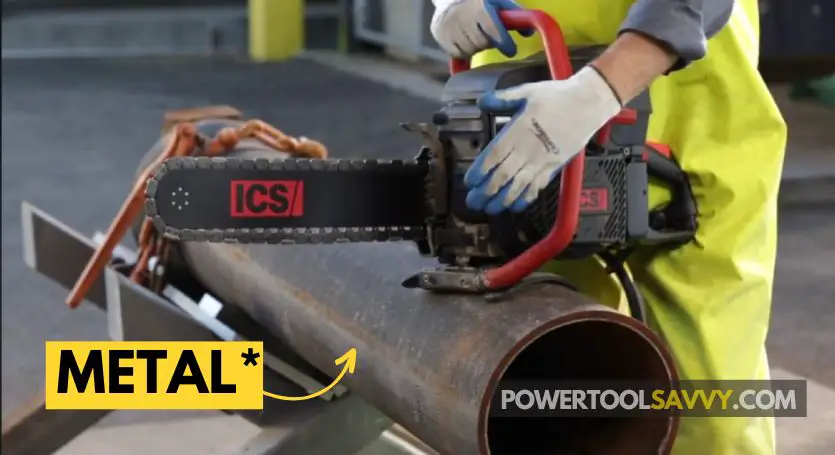
Well, you’re at the right place!
I have more than 20 years of using chainsaws. I’m going to answer the question in DETAIL so that you know exactly what to do.
Let’s get started…
Table of Contents
ToggleCan You Cut through Metal with a Chainsaw?
No, chainsaws with normal woodworking chains can’t cut through metal. However, there are specially designed carbide and diamond-tipped chains that can cut through metal, but they’re mostly for professional uses.
Plus, the SALTY truth is:
Those chains are so EXPENSIVE that I would say you’re better off investing in a quality angle grinder.
Also, cutting metal with a chainsaw is not practical at all.
If you force your chainsaw, then it may go through a pop can or a thin piece of aluminum siding, but the chain will be completely dull afterward (and may end up losing a few teeth).
I asked Brymond (a Husqvarna expert) about this, and here’s what she said:

Not only that!
Doing this will more likely THROW your chain off the bar and cause injury to yourself.
Related articles:
Chainsaw Chains are not Designed to Cut Metal
Let’s face it:
Chainsaw chains are not designed to cut metal in the first place.
If you take a closer look, tools that are specially designed to cut metal (e.g. angle grinders, hacksaws, cut off saws, etc.), have 2 things in common:
- an abrasive cutting wheel or a flat blade (A),
- and a bunch of teeth with a much shallower gullet along the edge (B).

On the other hand:
Chainsaw chains have relatively few teeth, and they’re angled in a way that they can NIBBLE off a sliver of wood with every pass.
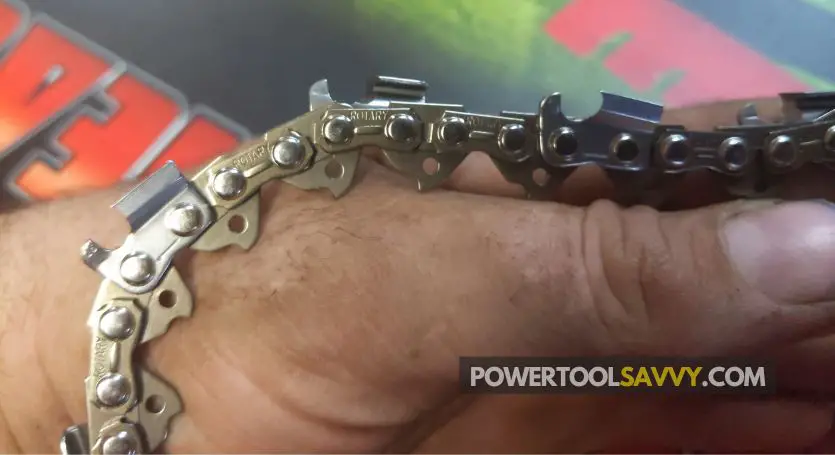
But metal is much HARDER and more rigid than wood, so the teeth won’t be able to make a cut, and will bounce off!
And, since only one tooth is hitting the hard metal surface at a time, the chainsaw will start to vibrate heavily and get difficult to control.
Here’s what Tully (One of our community members) has say,

Does Cutting Metal Dull the Chainsaw Chain?
Yes, cutting metal with a chainsaw can dull the chain. In some cases, you may even end up losing a few teeth of your chain and having to replace it.
Why?
Let me explain:
Do you know what chainsaw chains are made of?
Well, chainsaw chains are mostly made of relatively softer materials like “stainless steel,” so that they can be easily sharpened.
Stainless steel works GREAT when cutting wood. But when they meet “metal,” it’s a whole different STORY!
(You can picture it, can’t you?)
The moment a conventional steel chain touches a piece of metal, it starts to GRIND away and heat up.
Eventually, the heat and friction soften the chain and DULL the teeth.
The teeth will then just become thin pieces of steel hitting against the metal. They won’t be able to cut through the metal anymore and will break off at a point.
(I’ve destroyed 30+ chains in my life just by hitting nails and screws that were buried in wood.)
TRUST ME! It’s the worst feeling ever.
Here’s Jimmy, who has also experienced the same thing I did.

(If you haven’t guessed already, we both use regular chainsaw chains!)
But what about carbide and diamond-tipped chains? Can they cut through metal?
Let’s see…
Can Carbide Chainsaw Chains Cut through Metal?
As the name implies, “carbide chains” are made of tungsten carbide, which is a particularly hard metal. Therefore, these chains are capable of cutting harder materials like metal nails, ice, and hardwood.
They are way more EXPENSIVE than traditional chains and often claimed to last 4-5 times longer. But lookwise, there is hardly any difference.
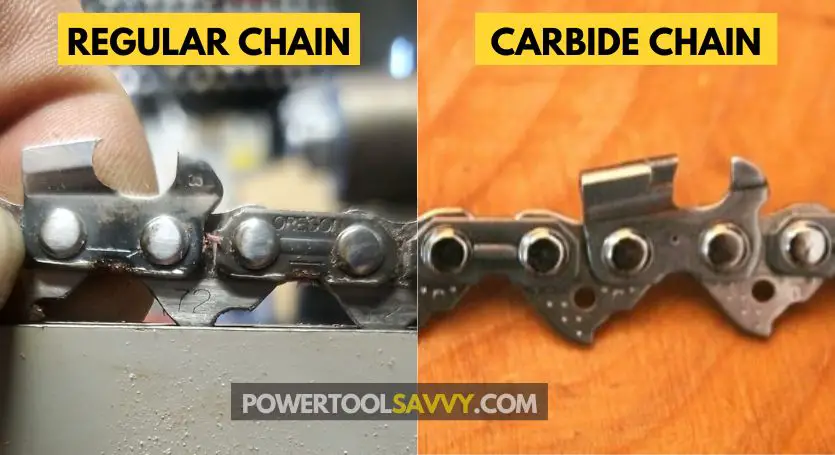
Despite so many benefits, you won’t see a lot of people using carbide chains to cut wood.
This is because these chains are –
- hard to sharpen (It can cost up to $50 depending on the size),
- expensive,
- and heavy.
That’s why carbide chains are mainly used by firefighters in RESCUE missions to enter burning buildings quickly.
But can you cut metal with a carbide chain?
Well, carbide chains do a little better job than normal chains when it comes to cutting through metal. However, they’re limited to framing nails, screws, copper pipe, and light gauge siding.
Still, there are chances that the teeth may get damaged and get useless for cutting anything!
So, if you want to use a carbide chain to cut through metal, you need to be willing to replace the chain afterward.
Here’s what a professional firefighter has to say about it:
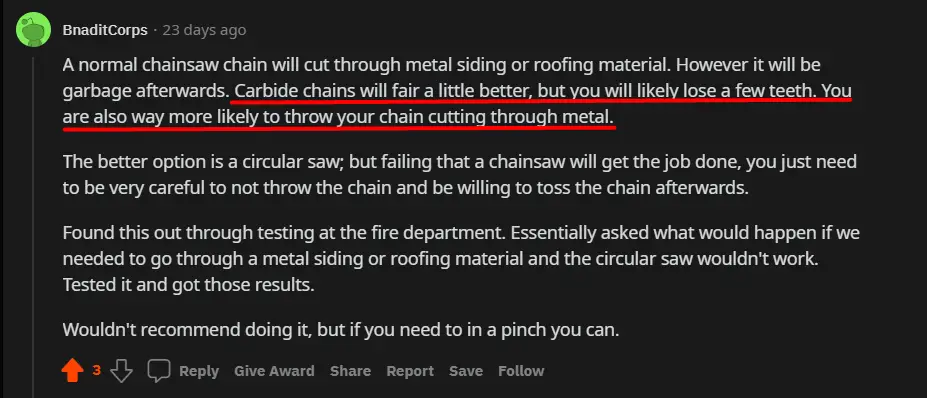
(Source)
Can Diamond-Tipped Chainsaw Chains Cut through Metal?
Yes, diamond-tipped chainsaw chains can cut through metal. With specialized design and diamond-tipped blades, these chains can slice through thicker than 1/2 inch rebar like butter.
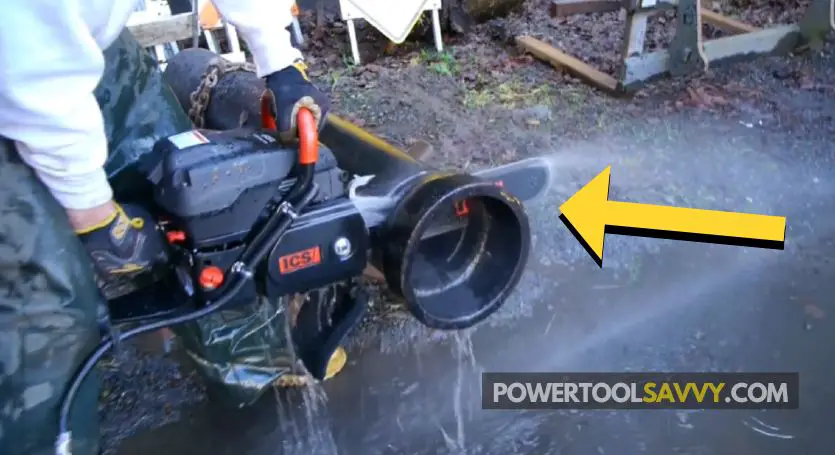
The DESIGN of diamond-tipped chains is completely different from normal woodworking chains.
If you’ve seen a diamond-tipped chain before, then you know what I’m talking about.
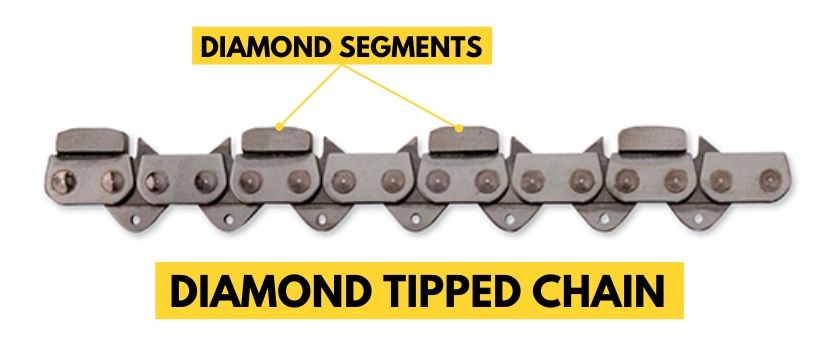
Rather than having sharp, angular teeth designed to cut through wood, diamond-tipped chains have rounded diamond segments embedded on top of each link which grinds through the hard surface and eventually wears it away.
(It’s more like sandpapering than sawing, really!)
These chains are MAINLY used by firefighters’ rescue operations when they need to access a building quickly.
Construction workers also use them to cut through metal pipe, concrete and hard rock.
But, for a layman (like you & me), there’s no PRACTICAL use for diamond-tipped chains at all!
At least, I won’t put that much money on a chainsaw chain only to cut metal (YES, they’re DAMN expensive!). I would rather buy an angle grinder with that money.
That’s not all
Even if you end up buying a diamond-tipped chain, you’ll need a specialized saw with a higher motor horsepower and a tougher guide bar than you would for standard chains.
Safety Tips for Cutting Metal with a Chainsaw:
It’s NOT recommended at all to cut metal with a chainsaw.
But, If there is no metal cutting tool available around and you’re planning to use a chainsaw, please remember to follow the safety tips below.
1. Make sure you wear protective gear
Anything can go wrong when you’re cutting metal, so make sure to always wear protective gear such as –
- Protective gloves (Important)
- Safety glasses (Important)
- Helmet (Optional)
- Ear protection (Important)
- Sturdy boots (Optional)
- Chaps and jacket (Important)
2. Use a metal detector
If you want to cut through logs that have metallic nails HIDDEN inside, I would recommend using a metal detector before you start cutting.
Doing this will HELP you locate the nails and take appropriate action to avoid any unfortunate incidents!
Trust me, nails can be really DANGEROUS!
Recently, I read this story on a forum where a guy lost his two fingers after hitting steel while cutting. Here’s what he said:
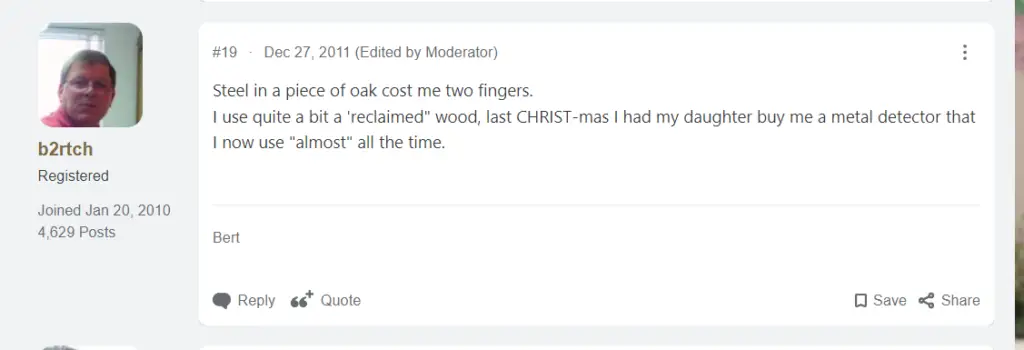
3. Keep the chain as tight as possible
It’s very important to keep the chain tight when cutting through metal. If the chain is TOOloose, it’ll come off and cause serious injuries.
Also, it can damage your guide bar and increase the RISK of kickback!
4. Be gentle and don’t force the cut
When cutting metal, make sure to be GENTLE and don’t force the chainsaw. Allow the saw to do its job; this will help you to get a smoother and cleaner cut.
Also, don’t push the saw too hard when cutting; it might cause kickbacks and make it difficult for you to grab control over the saw.
Goodbye Words!
Hopefully, this article answers all your QUERIES!
If I missed anything, just feel free to ask in the comments section.
Happy sawing!

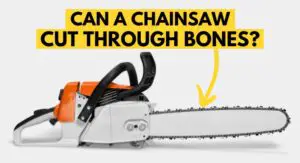
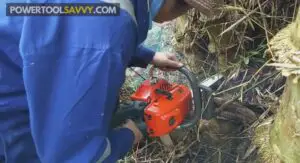



Pingback: Can You Cut Ice with a Chainsaw? Let's Find Out the TRUTH!
Pingback: Can a Chainsaw Cut Through Bone? (A Shocking Experiment!)
Pingback: Can You Cut Railroad Ties with a Chainsaw? (If YES, How to?)
Pingback: Can You Cut Wet Wood With a Chainsaw? What's the TRUTH?